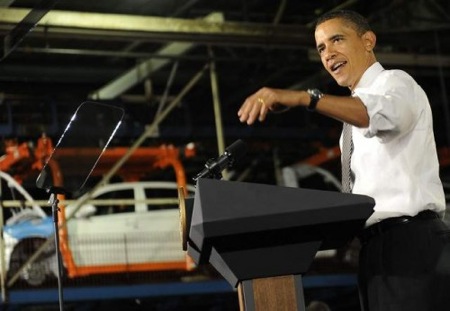
President Obama on Friday directed the EPA and the Transportation Department to develop a national policy to increase fuel efficiency and reduce greenhouse gas emissions from medium and heavy-duty trucks in time for the 2014 model year. The action comes almost exactly one year (May 19, 2009) after President Obama set new fuel and emissions standards for new cars and light trucks sold in the United States beginning with the 2012 model year.
The 2009 standards require manufacturers to raise average fuel economy for cars to 39 mpg , and light trucks and SUVs to 30 mpg by 2016. The EPA estimated the new standards would save 1.8 billion barrels of oil from 2012 to 2016, and reduce greenhouse gas emissions by 900 million metric tons, the equivalent of closing almost 200 coal-fired power plants.
Clean Car Legacy
Combined with the investments in clean car and new battery technology that were features of the 2009 American Recovery and Reinvestment Act, as well as the massive federal aid to prevent General Motors and Chrysler from going out of business, it is clear one of the significant climate action legacies of the Obama presidency is pushing vehicle manufacturers to produce more fuel-efficient and much cleaner products.
The White House announcement on fuel efficiency was dropped into an energy and climate news cycle that five months past the Copenhagen climate summit is suddenly spinning with significantly greater urgency.
The Gulf spill, growing larger by the day, is daily evidence of the lengths the nation was ready to take to satisfy its addiction to oil, and the massive economic and environmental damage deep sea drilling can cause.
Pragmatism and Principle
The American Power Act, introduced last week, includes troubling provisions designed to secure more offshore oil. But it also proposes to cap carbon emissions and provide for significant investments in clean energy, clean cars, transit and other energy conserving job-producing practices.
And the National Academy of Sciences published three studies this week that together again confirm that mankind is responsible for the warming earth and conditions are getting more dire.
All of this, and especially the American Power Act, has generated a moment-of-truth within the environmental community that is framed by the contest between pragmatism and principle. The new bill, if it passes, would be the second in as many years to focus substantial federal investment on emissions-reducing, job-producing, clean energy investments. Last year’s Recovery and Reinvestment Act included over $100 billion to jumpstart the transition to a low-carbon economy. The new climate and energy bill, along with proposing to reduce emissions 17 percent below 2005 levels by the end of the decade, also includes strong federal support for energy-conserving, and alternative clean energy practices and equipment.
President Obama, recognizing the deep division, fear, and skepticism that dominate this era, is nevertheless steadily making progress in responding to climate change. One other step he needs to take is to support the climate and energy bill. But in the tilt between pragmatism and principle it is not clear where American environmentalism will land.
— Keith Schneider